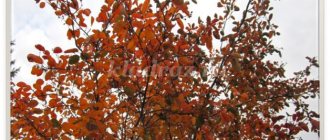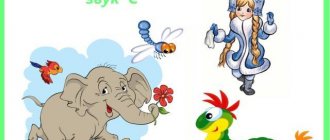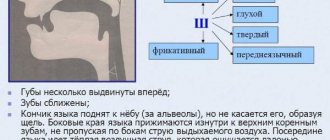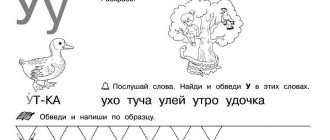Summary of a speech therapy lesson in the senior group on speech development “Trees in Autumn”
Goals:
- Development of coherent speech;
- Development of fine motor skills.
Tasks:
- continue to deepen children’s knowledge about autumn;
- learn to identify characteristic features;
- activate and enrich children’s vocabulary with adjectives on the topic of the lesson;
- fix the names of shades of colors;
- fix the names of geometric shapes;
- develop fine and gross motor skills;
- cultivate perseverance, cooperation skills, interest in the activity;
- cultivate a love for nature and a caring attitude towards it;
- Develop a responsible attitude towards completing the task.
Activation of the dictionary: autumn leaf, leaf fall, maple, rowan, birch, circle, square, triangle, rectangle.
Preliminary work: observing the weather while walking.
Equipment: geometric shapes (trail), visual material (tree applique), autumn leaves (birch, rowan, maple, poplar), colored paper, glue.
DURING THE CLASSES
L. – Children, today a letter arrived in our group, I didn’t open it without you. Let's open it together and read it. “I invite you to visit and see how beautiful the autumn forest has become. Mishutka,” but before we set off, let’s remember:
Conversation about autumn.
L. – What time of year is it now?
D. - Autumn.
L. – What do you think the autumn forest looked like?
L. – What can the autumn forest smell like?
L. – What can you hear?
L. – What are the leaves on the trees like in autumn?
D. – Yellow, red, orange
L. – How can you call yellow, red, orange leaves in one word? What are they? /Multi-colored/ (pronounced in chorus and individually)
L. – We go into the forest along an unusual path. What is our path made of?
D. – From figures.
L. – From what figures? Name it in one word.
L. – Geometric shapes (circle, square, oval, rectangle). Guys, what can you do in the forest? What can't you do?
D. – You can walk in the forest (relax, listen to birdsong, pick mushrooms and berries). Finger gymnastics
L. - One, two, three, four, five We will collect leaves, Birch leaves, rowan leaves, Poplar leaves, aspen leaves, We will collect oak leaves We will bring an autumn bouquet to the group.
Game “What is there a lot in the forest?”
L. – let’s tell you what there is a lot of in the forest. For example: “There are a lot of mushrooms in the forest. Mushrooms grow in the forest." Mushroom - mushrooms - a lot of mushrooms; Berry - berries - a lot of berries; Tree - trees - many trees; Leaf - leaves - many leaves;
L. – Look how many leaves I have here. Do you know which trees they fell from?
D. -Yes.
L. – Take any one leaf in your hands and say from which tree it fell.
D. - (take a leaf and name from which tree it fell). (a leaf fell from a birch tree, so what leaf is it? birch)
L. – What is the name of the phenomenon in nature when leaves fall? (Leaf fall.) Now let's remember everything we said about trees. /The leaves on the trees become colorful. The leaves are starting to fall. By the end of autumn the trees are bare./
L. – Now let’s try to make an applique of an autumn tree from colored paper of different colors and send this craft to Mishutka as a souvenir. What do you think Mishutka is doing now?
Children, together with a speech therapist, make an applique of an autumn tree from colored paper, fixing the shades of colors (burgundy, brown, orange, yellow, red).
Lesson summary
L. – What did you like in class today? You were all great today, you answered all the questions correctly. Bye for now.
Speech therapy lesson in 2nd grade on the topic “Signs of objects”
Topic: “Signs of objects.” Lexical topic “Description of a tree. Oak" Goals and objectives of the lesson.
Educational:
- determine the time of year, day of the week, know the signs of autumn, - form words - signs by analogy, - select words-signs based on the question: Which? Which? Which? Which? - compose a text - description using an algorithm.
Corrective and developmental:
- develop articulatory praxis, general and fine motor skills, - develop phonemic and syllabic analysis and synthesis of words, - develop the grammatical structure of speech, - develop coherent speech.
Educational:
- cultivate interest in the activity, love for nature.
Equipment: Illustrations of trees, cut-out pictures, syllabic material, breathing simulators, text material. Presentation.
During the classes.
1. Org. moment: greeting.
Posture control. Explanation of the speech task in the lesson. Issuance of an assessment sheet. Date, day of the week (today, yesterday, tomorrow) Time of year. (now, was, will be)
2. Speech exercises. (see lesson appendix)
Mimic exercises. Showing the joy of the beauty of autumn, the sadness of saying goodbye to summer, dissatisfaction with the rain - you can’t walk and smile at each other. Breathing exercises. Simulator “Autumn storm of leaves”
3. Conversation about the weather of the day.
Selection of offers according to the weather of the day.
4. Development of phonemic processes.
? Guessing the names of trees by sounds. (oak, linden, aspen, maple, elm, poplar, ash, rowan)? composing words from syllables (cut-out pictures), selecting the common name of trees. (deciduous) (lime, and avoy, rowan, birch, oak, aspen, maple, etc.)
5. Vocabulary work.
Development of grammatical structure of speech. Autumn piggy bank of words
? Formation of words - signs. Oak branch - oak, maple - ..., spruce - ..., pine - ..., linden - ... chestnut - ..., poplar - ... ? Selection of antonyms. The rowan tree has a thin trunk, but the oak tree... The aspen has a smooth trunk, and the elm…. Birch has light bark, but spruce has... The poplar is tall, and the ash... Cedar grows slowly, and maple... The wood of the viburnum is soft, and that of the oak... The branches of the willow are flexible, and that of the pine... I'm screaming.
6. Development of reading skills.
Reading the text "Oak". Retelling according to the text with windows instead of words - signs. Ophthalmic pause.
7. Development of coherent speech.
Compiling a story using an algorithm.
8. Correction of emotional state
Creative work. “Oak” Decorating an oak trunk with autumn leaves.
9. Homework.
Learn a tongue twister. There are bulls near the oak tree, and stumps under the oak tree.
10. Reflection. Results.
Materials for speech therapy classes
Speech exercises.
| In the morning the children went into the forest and found a lot of leaves. | 2 and 3 fingers “walk fingers straight, pressed, extended forward |
| The rain fell and disappeared, the contented forest rustles | Fingers drumming rubbing palms together |
| The clouds and leaves brightened like sails | Hands up tongue sail exercise |
| They trembled, perked up and forward - they bent back | Palms tremble, sag exercise for the tongue “low swing” |
| The wind lifts the leaves and lowers them to the ground | movements of the palms up and down; movements of the tongue up and down |
| The leaves are blown by the breeze to the west and east | movements of the thumbs left - right Movements of the tongue left - right |
| Quiet leaves rustle like balls flying | Circular movements of the hands Circular movements of the tongue |
| And the pines, fir, and Christmas trees have no leaves - only needles | index finger extended forward tongue exercise “needle” |
| And around on every hummock mushrooms stretch towards the sky | one hand is clenched into a fist, the second palm covers it like a mushroom, an exercise for the tongue “fungus” |
| The north wind blew the leaves from the trees - with with with with | Raise your hands, shake them, connect your fingers in a pinch, move them apart from the corners of your mouth |
| The reeds rustle by the river - sh sh sh sh | Place your palms together to form a cup |
| The cranes fly away screaming: Kurly - Kurly | Swing your palms |
Select weather offers.
The sun is shining. There are clouds in the sky. The sun is not visible. It's raining. Snowing. There is no precipitation. Strong wind blows. There is no wind. There is a slight wind blowing. The weather is sunny and cold. The weather is autumn, stormy. The weather is cloudy and cold.
Signs of autumn
The sky is covered with clouds. The sun peeks out from behind the clouds less and less. It often rains coldly. Sometimes it snows. The leaves on the trees turn yellow, red, and fall off. Leaves cover the ground with a colorful carpet. Birds fly away to warmer regions. Adults and children put on warmer clothes and changed their shoes. People are harvesting. Mushrooms and berries appeared in the forest
Selection of words - signs that are opposite in meaning
The rowan tree has a thin trunk, but the oak tree... The aspen has a smooth trunk, and the elm…. The birch has light bark, and the spruce….. The poplar is tall, and the ash…. Cedar grows slowly, and maple... Viburnum wood is soft, but oak... Willow branches are flexible, and pine...
Words for reference.
Thick, rough, hard, dark, fast, low, brittle. Challenges for ingenuity.
- On the balcony there were 2 oak leaves, 3 maple leaves and 1 apple. How many leaves were there on the balcony?
- The kid threw 1 spoon, 1 willow leaf and 2 forks into a bath of water. How many objects will float on water?
- What color are the leaves of a birch tree when there is snow on the ground?
Physical exercise. outdoor switchgear
| Leaf fall, leaf fall, yellow leaves are flying. | Arms raised, body tilted to the right - left. |
| They spin in the air and fall under your feet | Circular movements of the hands. Bend, squat. |
Finger gymnastics
| Wind and leaves | |
| The wind was blowing through the forest, the wind was counting the leaves. | Circular movements with the hands and the same in the other direction |
| Here - oak, here - maple, here - rowan, carved, here - from birch, gold. Here is the last leaf from the aspen tree | Bend the fingers of one hand one at a time. |
| The wind blew it onto the path. | Place your palms on your knees (on the table) |
Text
Oak. Oak is a mighty tree with rough bark, strong wood and strong roots that go deep into the ground. People say: “He’s as powerful as an oak tree, that’s why he’s loved.” Oak trees grow slowly. When the tree reaches twenty years, acorns appear on it. And these trees live for four hundred to five hundred years. An oak forest is called an oak forest. People cherish and protect these amazing plants.
Tree description algorithm
There are bulls near the oak tree, and stumps under the oak tree.
Evaluation sheet.
| № | Exercise | mark |
| Knowing the signs of autumn | ||
| Articulation warm-up | ||
| Autumn piggy bank of words | ||
| Correct, independent picture folding | ||
| Correct, expressive reading of text | ||
| Retelling the text by substituting words into the test | ||
| Compiling text according to a picture plan | ||
| Performing general and finger exercises | ||
| Creative work “Oak” | ||
| Bottom line |
Author of the material: Eropolova Lidiya Vasilievna
Also on the topic:
Homework on a lexical topic: “Spring”







